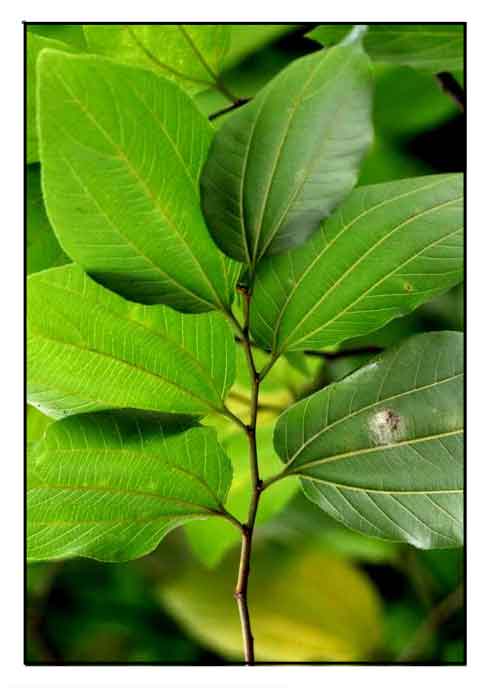 Gen info Gen info
- Ziziphus is a genus of about 40 species of spiny shrubs and small trees in the buckthorn family, Rhamnaceae, distributed in the warm-temperate, subtropical, and tropical regions of the world.
-
The city of Mabalacat in the province of Pampanga was named after the 'balakat' tree.' It became a town in 1712, at which time it was a settlement of a Negrito tribe, and the area a virtual forest of 'balacat' trees. Mabalacat is considered an indigenous word meaning "full of Balakat trees."
- Decreased population decline has been attributed to habitat loss through logging, road widening, building construction, and various infrastructure projects. A "Balakat Greening Project" was launched in 2008" to preserve and conserve the Balakat trees. An ordinance declared the Balakat as the city's official tree. (3)
 Botany Botany
Mabalacat is a large tree characterized by its tall, straight, cylindrical and thorny trunk, up to 30 m high and 100 cm in diameter. Characteristic of Ziziphus species: Leaves alternate, entire, with three prominent basal veins; flowers small, inconspicuous yellow-green; fruits drupes, 1-5 cm long. (No detailed botanical information available at this time.)
Distribution
- Endemic to Luzon and Visayas in the Philippines.
- Found in the Philippine Limestone Forest ecoregion.
- Scattered in lowland primary or secondary forests up to 1000 m altitude.
- Decreased population decline due to habitat loss through logging, road widening, building construction, and various infrastructure projects. (3)
- IUCN Red Listed as "Vulnerable".
 Constituents Constituents
- Study of aqueous and ethanolic crude leaf extracts yielded glycosides, condensed tannins, and saponins in both extracts, and leucoanthocyanins only in the aqueous extracts. (4)
- Phytochemical screening of ethanol leaf extract showed lower concentrations of triterpenes, alkaloids, and glycosides; moderate concentration of sterols; and higher concentrations of flavonoids, tannins, and saponins.
(see study below) (10)
Properties
- Studies have suggested antibacterial, antifungal, hepatoprotective, reproprotective, nephroprotective, neuroprotective, molluscicidal properties.
Parts used
Leaves, bark.
Uses
Edibility
- Species under this genus produce two-seeded edible fruits.,
Folkloric
- In Antique Province, bark is used for treatment of ringworm. scabies, and urinary tract infections.
Others
- Wood: Used for general construction, furniture making, cabinetry, manufacture of plywood.
 Studies Studies
• Molluscicidal / Leaf Powder: Study evaluated balakat (Ziziphus talanai) leaf powder as an alternative molluscicide against golden apple snail (Pomacea caniculata) in direct seeded rice areas. Study showed the application of dried balakat leaf powder at 7 kg/ha is a feasible, safe, low-cost, and farmer-accepted alternative to molluscicide control, with reduced detriment to soil environment. (2)
• Lack of Antibacterial Activity / Leaves: Study evaluated aqueous and ethanolic crude leaf extracts of Z. talanai for antimicrobial activity using disc diffusion method against E. coli and S. aureus. Results showed no antibacterial activities. (see constituents above) (4)
• Amelioration of Behavioral Aberrations and Altered Cerebellar Histology in Murine Model of Autism: Exposure of brain to valproic acid (VPA), an antiepileptic drug, can lead to motor behavioral and neuroanatomical anomalies congruent with autism-spectrum disorders (AS). Study evaluated the effect of ethanol leaf extract for neuroprotective effect in a murine model of autism. Administration of leaf extract showed comparable significant improvements in neurobehavioral retardation and regression and cytological construction of Purkiinje cells in the cerebellum. Results suggested the leaf extract possesses ameliorative potentials against behavioral aberrations and altered cerebellar histology in VPA (valproic acid)-induced postnatal autism in murine models. (5)
• Antimicrobial / Anti-Mycobacterium phlei Activity / Bark: Study of methanol extract of bark of Z. talanai exhibited antimicrobial activity against Gram-positive Mycobacterium phlei, S. aureus and B. subtilis at 20,000 µg and 2000 µg, but was inactive against Gram-negative E. coli, P. aeruginosa, C. albicans, and S. cerevisiae. It showed minimal antifungal activity against T. mentagrophytes. Bioassay-guided isolation yielded ceanothic acid, which showed activity specific to M. phlei at 100 µg. M. phlei is a species of acid-fast bacteria in the genus Mycobacterium, which can cause chronic ambulatory peritoneal dialysis-associated peritonitis. (6)
• Hepatoprotective / Reproprotective / Leaves: Study evaluated the histoprotective effect of ethanol extract of Z. talanai leaves against tetracycline-induced hepatotoxicity and reprotoxicity in male mice. hepatotoxicity was evidenced by central vein rupture, fibrosis, vacuolations, cytoplasmic degeneration, lymphocyte infiltration, while reprotoxicity was indicated by irregularly shaped tubules, narrowing of tubule diameters, widening of lumen, germinal epithelium exfoliation, blood-testis barrier destruction, among others. Results showed the talanai leaf extract mitigated hepatotoxicity and reprotoxicity effects of tetracycline as evidenced by improvement in hepatological and testicular parameters. (7)
• Nephroprotective Against Gentamicin Toxicity / Leaves: Study evaluated the nephroprotective potentials of Z. talanai ethanol leaf extract against gentamicin-induced nephrotoxicity in male ICR mice models. Results showed significant increase in kidney weight and body weight and significant decrease in creatinine and blood urea nitrogen. Study showed nephroprotective effect attributed to bioactive compounds. (see constituents above) (10)
• Neuroprotective / Antinecrotic against MSG-Induced Cytoarchitectural Alterations in the Brain: Study evaluated the antinecrotic potential of Z. talanai against monosodium glutamate-inudced cytoarchitectural alternations of the prefrontal cortex of 20 male albino mice. Results suggest Z. talanai exerts antinecrotic capacities in the mous brain. (11)
Availability
Wild-crafted.
Seeds
in the cybermarket.
|

![]()






 Studies
Studies 